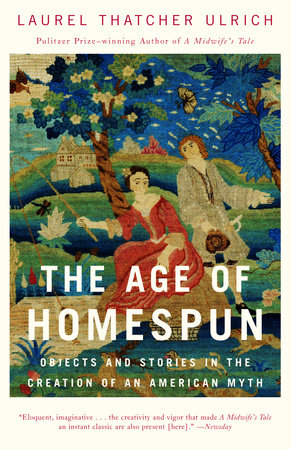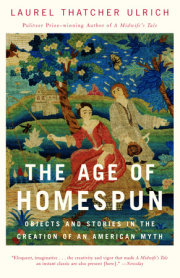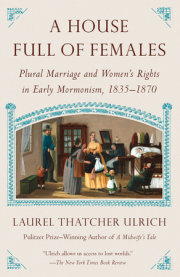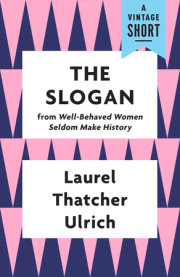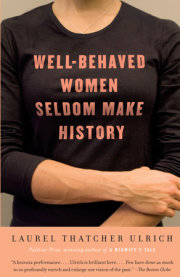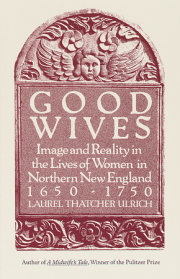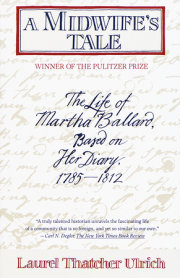Chapter 1
The basket is four and a half inches high and four inches in diameter, about the size of a large tomato can, though smaller at the top than the bottom. When new it could have held a generous pound of meal or beans or twenty-four fathoms of wampum. Now light leaks through a weft ravaged by time and insects. The basket holds it shape through hundreds of invisible mends, the unseen art of a conservation lab. Tiny twists of rice paper bonded with unpronounceable adhesives like polyvinal acetate and polymethyl methacrylate fill gaps in a fragile fabric strengthened by multiple infusions of soluble nylon in ethyl alcohol. Would the basket be as precious without its story?
It came to the Rhode Island Historical Society in 1842 with a label carefully written by the donor:
This little basket, was given by a squaw, a native of the forest, to Dinah Fenner, wife of Major Thomas Fenner, who fought in Churche's Wars; then living in a garrison in Providence, now Cranston, R.I. The squaw went into the garrison; Mrs. Fenner gave her some milk to drink, she went out by the side of a river, peeled the inner bark from the Wikup tree, sat down under the tree, drew the shreds out of her blanket, mingled them with the bark, wrought this little basket, took it to the garrison and presented it to Mrs. Fenner. Mrs. Fenner gave it to her daughter, Freelove, wife of Samuel Westcoat, Mrs. Westcoat gave it to her granddaughter, Wait Field, wife of William Field at Field's Point, Mrs. Field gave it to her daughter, Sarah. Sarah left it to her sister, Elenor, who now presents it to the Historical Society of Rhode Island.
The reference to "Churche's Wars" led nineteenth-century antiquaries to date the basket to 1676, the year Captain Benjamin Church of Little Compton, Rhode Island, led New England troops in victory over the Wampanoag leader Metacomet, or King Philip. No one since has doubted the attribution.2 Displayed in the late nineteenth century alongside other relics of Rhode Island's first century, the basket quieted a troubling history of frontier conflict. Exhibited today as an icon of native art, it fulfills much the same purpose, shifting attention from the violence of the late seventeenth century to our own generation's hopes for multiculturalism.
The details in Field's description line up like clues in a mystery: a garrison, milk, a Wikup tree, shreds from a blanket, and those evocative names-Dinah, Freelove, Wait. There was a Dinah Fenner who lived in Rhode Island in 1676, though in that year her name was Dinah Borden, and she was only eleven years old. She did eventually marry Thomas Fenner, a man who helped to defend Providence in King Philip's War, and they did have a daughter named Freelove who had a granddaughter named Wait. Yet there is much in the story that remains puzzling. If the basket was made by "a native of the forest," why would she have come to an enemy garrison in time of war seeking milk, a food repulsive to a people known today to be lactose intolerant? Was she a refugee? So desperately hungry she was willing to accept any food offered? If so, how does one explain the basket? The exposed warp is indeed rough, but the twined pattern is intricate and artful. Could its maker have stripped and soaked fibers from the inner bark of a tree, gathered husks from an abandoned field, then patiently sat on the bank of a river weaving in a time and place where even friendly Indians were in danger? That hardly seems likely, yet laboratory analysis tells us there are fragments of red and blue wool still clinging to the interior of the basket. Could they have come from an English blanket?
The twentieth-century Narragansett historian and basket-maker Ella Sekatau once told a visiting scholar about a curious window in an old schoolhouse near her Rhode Island home. One pane was of "old, old glass," ridged and warped. Looking into it, people saw things that weren't there, like "a sea with Indian people, and it didn't match with the window next to it" or ancient figures standing by a big stone outcropping. Everybody saw different things, not the actual objects that sat on the other side of the window, but shadowy scenes from somewhere else. "My cousin's husband said you shouldn't have things like that, and he broke it."
Dinah Fenner's basket is that kind of window. Some will use it to imagine a history more intimate and peaceful than the one in books. Others will find nothing in it they can trust. Interpreting such an object requires both imagination and skepticism, imagination to see new possibilities in an old story, but skepticism about its placid surface. Here the important question is not how a Rhode Island woman got her basket, but why milk, a basket, and a blanket should appear in the same narrative. Rereading the early history of New England with these objects in mind transforms an apocryphal story into a powerful lens for understanding exchange relations in the first century of English settlement. To write about blankets is to write about the expansion of English commerce. To write about baskets is to discover the little-known work of Native American women. To search for the meaning of milk is to find the biblical vision that animated the English quest for land. The history of Dinah Fenner's family brings these themes together in unexpected and disturbing ways, providing a solution to the origins of the basket that is less literal than Field's telling yet true to its larger themes.
The English who came to the coast of what is now New England in the early 1600s were not all alike. Some came to fish, some to pray, and among those who prayed there were enough differences to keep them squabbling and sometimes hounding one another from colony to colony for generations. The people they found here also differed. Although scholars sometimes refer to them collectively as Algonkians, they spoke different dialects, inhabited different river basins, and assigned a bewildering array of names to one another. In terms of textile history, however, Englishmen and Algonkians differed more from each other than they did among themselves. The English came from a wool-producing country proud of its blankets. Algonkians were renowned for their basketry.
Archaeological sites on coastal New England are littered with lead seals once attached to bolts of fabric. As the Englishman Richard Hakluyt espressed it in a 1584 treatise, the second purpose of colonization, after advancing the "kingedome of Christe," was the vending "of the masse
of our cloths and other commodities." The English did that with a vengeance.Yet the first Englishmen to visit North America were fascinated with the unfamiliar fabrics they found in Indian villages. Among the Algonkians, textile production was women's work. Men worked in stone, metal, and wood, producing impressive tobacco pipes, knot dishes, pendants, and other ornaments. Women made netted, twined, sewn, and plaited textiles to cover their houses, dry corn, trap fish, store provisions, carry produce, and line graves. In the words of one English observer, they made baskets of "rushes, some of bents; others of maize husks; others, of a kind of silk grass; others of a kind of wild hemp; and some of barks of trees, many of them, very neat and artificial, with the portraitures of birds, beasts, fishes, and flowers, upon them in colours." Men hunted and cared for tobacco fields. Women planted, hoed, and harvested food crops, storing them in containers of their own manufacture. Rhode Island's Roger Williams described heaps of maize "of twelve, fifteene, or twentie bushells a heap" drying on woven mats by day, covered with tarps of basketry at night.
One writer claimed to have seen an immense basket buried in the earth that held sixty gallons of maize. Another said Indian containers ranged in volume from "a quart to a quarter" (in archaic usage a quarter was eight bushels).Tightly woven bags of soft hemp held the parched maize called nokake in some dialects and yohicake, yoheag, yokeg, or nokehick in others, a food "so sweet, toothsome, and hearty, that an Indian will travel many days with no other food but this meal, which he eateth as he needs, and after it drinketh water." Williams claimed to have traveled with an Indian band "neere 100 miles through the woods, every man carrying a little Basket of this at his back, and sometimes in a hollow Leather Girdle about his middle."
Although Europeans had their own basketry traditions, basketry was far more varied among the Algonkians. Thomas Morton wrote of mats made by stitching together long strips of what the English called "sedge" with "needles made of the splinter bones of a Cranes legge, with threeds, made of their Indian hempe." In preparation for netting or weaving, women spun fine fibers between their fingers or across their thighs. William Wood said that Indian cordage was "so even, soft, and smooth that it looks more like silk than hemp." Other writers admired the "curious Coats" or mantles of turkey feathers that women wove together "with twine of their owne makinge, very prittily." John Josselyn, who spent much of his time in northern New England, described "Delicate sweet dishes . . . of Birch-Bark sowed with threads drawn from Spruce and white Cedar-Roots, and garnished on the outside with flourisht works, and on the brims with glistering quills taken from the Porcupine, and dyed, some black, others red."
Wigwams were also a form of basketry. Wood said that women framed them like an English garden arbor, "very strong and handsome," then covered them "with close-wrought mats of their own weaving which deny entrance to any drop of rain, though it come both fierce and long, neither can the piercing north wind find a cranny." Observing Indians along the Maine coast a little later in the century, Josselyn described similar structures "covered with the bark of Trees" and lined inside "with mats made of Rushes painted with several colours." Two different marsh plants-cattail (Typha) and bulrush (Scirpus)-yielded different fabrics. Sewn in overlapping layers, the leaves of the cat-o'-nine-tails swelled and exuded a gummy substance when wet, giving exterior mats their waterproof quality. Rushes, on the other hand, dried quickly and when combined with other fibers, such as the soft inner bast of cedar, could be woven into soft and absorbent mats as decorative as they were practical. These mats gave Indian dwellings their portability. "I have seen half a hundred of their Wigwams together in a piece of ground and they shew prettily, within a day or two, or a week they have been all dispersed," Josselyn wrote.12 Wigwams moved because work moved. Coastal groups cultivated fields of maize, beans, squash, and tobacco in summer, mov-ing to warm interior valleys in winter where game and fuel were more plentiful.
The most exotic textiles required both male and female labor. Men drilled and ground the beads called wampum from periwinkle, conch, and whelk shells or from the blue-black centers of the quahog. For ordinary exchange, these were strung into lengths the English measured in fathoms, but for ritual regalia, women wove the beads into "pleasant wild works" with warps of sinew and wefts of hemp. A wampum band worn by the Wampanoag leader Metacomet was nine inches wide and long enough to reach from a man's shoulders to his ankles. It was edged with red hair said to have been acquired in the Mohawk country. Metacomet's accoutrements, according to Josselyn, were worth twenty pounds in English money, or five times as much as all the clothing and bedding he recommended an English immigrant bring to New England.
Although English writers admired Algonkian textiles, they had difficulty explaining their decorative qualities. The best analogy they could find was to the needlework of upper-class women, but since Indian women also did field work, this only confused the issue. The most elaborate exploration of the problem is in a Latin poem with English translation published by William Morrell, who spent a year at Plymouth in 1623. Morrell compared decorative mats to the pictorial tapestries or "arras" found in English country houses and the "curious finger-worke" he found in Indian villages to passementerie or parchment lace. Yet he puzzled over the fact that Algonkian women combined this delicate work with physical labor. "These hands doe digge the earth, and in it lay / Their fair choyce corne, and take the weeds away." Native women confounded English notions of class by combining outdoor labor with fine finger work and English notions of gender by performing agricultural labor the English assigned to men. While women worked, men, Morrell believed, spent their days "in play, / In hunting, armes, and pleasures."
The division of labor among Native Americans was probably more complex than the simple male-female divide described in English accounts. Surely there was some heirarchy of age, skill, or status in textile production, and the sexual division of labor was not as fixed as it might seem. Williams said that men cut and set the long poles for houses, and that even in agricultural work, "sometimes the man himselfe, (either out of love to his Wife, or care for his Children, or being an old man) will help the Woman which (by the custome of the Countrey) they are not bound to." Williams no doubt idealized the noncompetitive virtues he wished to inculcate among his own people when he wrote of "friendly joyning" to break up fields, build forts, hunt, or fish, but his description of work parties of forty, fifty, or a hundred men and women corrects others' accounts of female drudgery and male leisure. His observations reinforce the larger point, however, that female as well as male labor was visible to and admired by outsiders.
Nothing survives that can fully convey the complexity of seventeenth-century Algonkian textiles, but Dinah Fenner's basket read alongside archaeological fragments helps us to understand some of the techniques and materials used. The warp is of bark, the wefts of wool and of a flatter material that may have been cornhusk. The construction is complex. The weaver began with a plaited base, using three strands of bark for each warp, then moved to simple twining and finally to a technique called "wrapped twining" in which two wefts, one active and one passive, intersect the warp. By changing the color as she wrapped, she produced the pattern. The technical details are important because they locate the basket in an ancient textile tradition. Shreds of twining very similar to that in Dinah's basket have been found in northern Vermont in archaeological sites dating from the Early Woodland period (1000-100 b.c.). One fragment even revealed a faint chevron created by weaving animal hair in two colors. Except for the wool in its weft, Dinah's basket could have been made a thousand years before the first European excursion to North America. It only hints at the variety of early textiles. Through electron microscopy, archaeologists have identified early baskets woven from the "bast" or stem fibers of wild hemp, dogbane, milkweed, and nettles, as well as the fibrous inner bark of slippery elm, black willow, cedar, and basswood. Excavations from later sites include plaited and sewn matting, coiled netting, and twined textiles of many kinds.
Other bags and baskets thought to have been made in the early colonial period suggest the range of techniques and designs. On July 4, 1842, the same year that Eleanor Field presented her great-great-grandmother's basket to the Rhode Island Historical Society, a Norwich, Connecticut, man donated a twined bag to the Connecticut Historical Society in Hartford. It, too, came with a story. He said he had received it "from Cynthia, now 60 or 70, and daughter of Lucy Tocamwap, the first member of the Mohegan church. By tradition of her own family Cynthia believes the basket to be near 300 years old." He called it a Yohicake bag. If so, it was an extraordinarily large one. Measuring 13 1/4 by 9 1/4 inches, it could have held as much as three quarts of meal. The upper edge originally had twenty-four eyelets through which a drawstring could have been threaded. Unlike Dinah Fenner's basket, the Mohegan bag is a soft textile, flat when empty. In each row, the weaver twisted two weft threads around each warp in a kind of spiral, then inserted porcupine quills in two shades to create the design. The banded design, though similar to painted motifs on later Mohegan baskets, is quite different from the stepped diagonals on Dinah's basket.
A third bag or basket with a New England provenance is closer in size to the Yohicake bag but closer stylistically to Dinah's. Called a wampum bag by its present owners, it ostensibly belonged to a Haverhill, Massachusetts, woman who was taken captive in the late seventeenth century. A later owner edged it with chintz and turned it into a sewing basket. This basket, like Dinah's, has strong diagonal elements with serrated edges and negative stripes. A fourth example came to a Massachusetts museum in 1989. Although it has no history, textile experts believe it, too, is colonial. Like Dinah's basket, it mixes wool with bark. The handling of the materials is different, however. The warps are "plied" or doubled and the wool worked in later, as with the porcupine quills on the Yohicake bag. The variations in the four baskets may reflect individual preferences, change over time, or stylistic differences among neighboring Algonkian peoples. The twining techniques, however, link all four to ancient American textiles.
Archaeological evidence documents the similarities and differences between European and indigenous fabrics. At a Wampanoag site on the west side of Narragansett Bay, archaeologists found sixty-six fragments of native basketry alongside seventy-three relics of European cloth. The European fabrics ranged from bits of a white wool blanket with end stripes of red, blue-green, and brown to a long coil of a trimming called "galloon" woven in yellow silk with twists of silver thread. The Algonkian textiles included ordinary matting as well as fabrics too complex and individual for an English loom-a belt of glass beads woven with sinew, a wampum collar skillfully shaped to fit the curve of a neck, and fragments of matting that incorporated as many as three techniques in a single swatch.
Though made from different fibers and for different uses by people in radically different circumstances, many employed identical weave structures. A mat of undyed vegetable fibers, for instance, and a fabric of brown wool both exemplify "plain weave," the simple over-under technique that most of us learned in childhood. Another fragment woven in what textile specialists would call a "2/2 twill" is identical structurally to the pieces of English blanket found on the same site. Other samples demonstrate that Algonkian as well as English weavers knew how to vary plain-woven fabrics by combining warps and wefts of different materials or weights.
What was different about the two sets of textiles was not their structural sophistication or the abilities of their makers, but their mode of production. In the Middle Ages, Europeans had perfected a method of producing large quantities of fairly simple fabrics through the use of spinning wheels and looms. Equally important were changes made in the early modern era in the division of labor. English fabrics traded in North America were made in an economy that divided work into many parts. A hierarchy of workers performed a small set of tasks over and over again, middlemen in one part of the kingdom selling wool, spun yarn, or undyed cloth to intermediaries in other towns who passed them along a production chain that stretched from one end of the British Isles to another and across the Atlantic to America.
For Europeans, flax was the most important vegetable fiber. Depending on soil and weather, it produced a long silky "line" used in linen or a shorter, rougher fiber called "tow." Sheep provided both "wool" and "worsted," a difference created not only by alternative ways of feeding the animals, but from different methods of preparing fleeces for spinning. Carding oriented the fibers of short, crimpy wool horizontally, so that when spun they formed a fuzzy surface or nap on the finished cloth. Fulling or pounding accentuated the effect, creating a dense surface that could be sheared. Long hairy worsteds, on the other hand, were combed longitudinally to create smooth fabrics that could be glazed or pressed. Woolens were the basis of the heavy cloths historians call the "Old Draperies." By the early seventeenth century, lighter fabrics made of worsted, alone or in combination with linen, wool, or silk, became important. These were sometimes called "Tammies," from the French word estame.
A broadside celebrating a parliamentary bill protecting worsted shows one artist's perception of the organization of English manufacturing. In the center, an unbroken circle of male weavers joins hands around the bonfire as giddy women, portrayed here as consumers rather than as workers, throw foreign imports into the fire. Smaller images around the border symbolize the many groups, from spinsters to landlords and from wool combers to alehouse keepers, sustained by worsted manufacturing. What is remarkable about this image is its emphasis on the compartmentalization of production. Combing, spinning, dyeing, and dressing are as separate from one another as plowing and sailing.
What was true of worsteds was true of wool as well. In a famous description of the blanket makers of Witney in Oxfordshire, Robert Plot explained how wagons went weekly from Witney to London, returning with "fells" wool taken from animals slaughtered in "the furthermost parts of the Kingdom" and gathered into London for marketing. Witney manufacturers sorted the wool from these fleeces into half a dozen grades, shipping long stapled worsted to stocking manufacturers, reserving the best "Bay-wool" and "Head-wool" to make their most expensive blankets, and designating "Middle" and "Ordinary" wool for medium-priced products, some of which they mixed with local fleeces for the cloth they called "duffels." They used "tail-wool" for seamen's blankets and worked what was left into a rough fabric called "Wednel" used to stiffen collars, wrap bales, or cover barges. Plot estimated that Witney's blanketers kept 150 looms in active service, employing "3000 poor People, from Children of eight Years old, to decrepit old Age." Sorting, warping, weaving, fulling, dyeing, and finishing were men's work. The children and old folks did the carding and spinning.
This was the division of labor Adam Smith theorized nearly a century later in The Wealth of Nations when he described a plain woolen coat worn by a day laborer. "The shepherd, the sorter of the wool, the wool-comber or carder, the dyer, the scribbler, the spinner, the weaver, the fuller, the dresser, with many others, must all join their different arts in order to complete even this homely production." Subdividing work increased productivity by reducing "every man's business to some one simple operation," by saving "the time commonly lost in passing from one sort of work to another," and by allowing the "application of proper machinery." By the time he wrote, both the subdivision of labor and the application of machinery had advanced considerably, but the general direction of change had been established much earlier. Seventeenth-century writers would have understood Smith's contrast between civilized and uncivilized economies. In "savage nations" everyone worked but everyone was at the same time "miserably poor." In "advanced and thriving nations," some people worked hardly at all and consumed ten times more than others, yet every one was enriched. "It is the great multiplication of the productions of all the different arts, in consequence of the division of labour, which occasions, in a well-governed society, that universal opulence which extends itself to the lowest ranks of the people." Hence, an industrious peasant in an advanced society was more wealthy than an "African king" who was the absolute master of "ten thousand naked savages."
American Indians were among the earliest models for the European notion of the "naked savage." An icon of a man dressed only in leaves was impressed in wax on the earliest official documents of the Massachusetts Bay Colony. Although the details of clothing and even the sex of the Indian on the colony's seal changed over time, most versions included the plaintive cry "Come over and help us," an adaptation of a passage in the Book of Acts describing the apostle Paul's vision of a man praying, "Come over into Macedonia, and help us." In the English view, New World "savages" needed both spiritual and material clothing. Christianity and good English cloth came together.
Yet writers who emphasized Indian nakedness sometimes described Indian clothing in some detail. Williams's Key into the Language of North America included Algonkian words for coat, mantle, waistcoat, apron, stockings, and shoes. He admired, and perhaps even tried, native footwear, which "being excellently tann'd by them, is excellent for to travell in wet and snow; for it is so well tempered with oyle, that the water cleane wrings out; and being hang'd up in their chimney, they presently driee without hurt as myself have often proved." He differentiated the aprons or breechcloths that adults of both sexes wore and the loose wrappings that they picked up and put down as required. William Wood referred to women's wrappings as "beaver petticoats." When Daniel Gookin wrote that the "Indians' clothing in former times was of the same matter as Adam's was," he wasn't referring to the nakedness of the first couple or to the aprons of fig leaves they constructed for themselves but to the "coats of skins" God gave them when he banished them from the Garden of Eden.
The English wanted these coats. The makers of high-style hats eagerly sought American beaver since it was the only fiber that when felted was both strong and supple enough to sustain its shape when wet. Thomas Morton reported that in the 1630s beaver sold for ten shillings a pound. Presumably that was the price given to the English broker, not the Algonkian supplier, but at ten shillings, a single pound of beaver would have purchased two and a half pounds of broadcloth, the most expensive of the English fabrics. Algonkians gave up Adam's clothing not because it was inferior to English cloth but because it had become too valuable to wear. The half-naked Indian on the Massachusetts seal obscures the interconnectedness of Adam's and Adam Smith's clothing.
Indians did not exchange their beaver mantles for broadcloth but for duffels, or "trucking cloth," a kind of blanketing woven about sixty inches wide and dyed in deep colors. Plot said the Witney manufactories dyed most pieces "Red or Blue, which are the Colours that best please the Indians of Virginia and New England." He believed the Indians tore duffels into "Gowns of about two Yards long, thrusting their Arms through two Holes made for that Purpose, and so wrapping the rest about them as we our Loose coats." No other seventeenth-century source mentions the armholes, though New England writers agreed about the length. The earliest writers used the terms duffels and blankets interchangeably. By midcentury, the common term for a two-yard length of trucking cloth was "Indian Coat." William Wood described customers at English trading posts choosing "a good coarse blanket, through which they cannot see, interposing it between the sun and them" to make sure it was of the proper weight and thickness. This they used for "a double end, making it a coat by day and a covering by night."
His description displayed both arrogance and grudging admiration: "They love not to be imprisoned in our English fashion. They love their own dog fashion better (of shaking their ears and being ready in a moment)." Like other seventeenth-century writers wood saw the Indian preference for loose wrappings from a stance of cultural superiority: Indians wore blankets because they were animal-like and because they didn't know better. Some twentieth-century scholars have been almost as ethnocentric, arguing that because "Indians had no woven cloth before the arrival of European traders and settlers," it took time for their women "to learn sewing skills." Others assume that Indians were attracted to woven fabrics because they "were lighter and more colorful than animal skins and nearly as warm," as though the replacement of one form of clothing for another were a simple matter of consumer choice.
What these explanations miss are the asymmetries between European and Algonkian textiles. Indians didn't adopt English blankets because they were superior to their traditional clothing but because furs and hides purchased new products like iron pots, knives, and guns. It is hardly surprising that the wearers chose to use their new clothing very much as they had the old. Nor did Indian women have any reason to take up English textile tasks when they were so fully occupied with their own. A trucking-cloth blanket might replace a mantle of skins, but it could not roof or furnish a wigwam. Trade with Europeans had a profound impact on male hunting and on the trading and manufacture of wampum which became a kind of currency in the fur trade, but it had little effect on women's other textile work. A hundred years after contact, Algonkian women were still weaving mats for wigwams and baskets to store and carry food.
Unlike wampum, baskets had only a minor role in English-Algonkian exchange. In a letter forwarding "30 fathom of Beades" to Governor John Winthrop of Massachusetts, Roger Williams offhandedly mentioned that he had sent a basket, "a present from Miantunnomues wife to your deare Companion Mrs Winthrop." To the Narragansett sachem and his wife Wawaloam the basket may have had as much diplomatic meaning as the beads, but to Williams it seemed a mere gratuity. Wood also described exchanges between Indian and English women as "gifts." "These women resort often to the English houses," he wrote, adding that they usually brought with them "something that is either rare or desired, as strawberries, hurtleberries, raspberries, gooseberries, cherries, plums, fish, and other such gifts." Mats and baskets must have entered into these exchanges, though evidence of their presence survives only by accident. A Springfield court record, for example, mentions "a double Indian mat compassing the bed." A Salisbury, Massachusetts, witch trial told of "a little Indian basket" that wouldn't stay in the loft where it was kept. (That an ordinary English brick had the same propensity shows that Indian goods had no monopoly on enchantment.)
Baskets are hard to find in early records because they resisted commodification. As manufactured products they were less valuable to the English than furs and skins, nor were the materials of which they were made of particular interest to colonists. Where Indian women found abundant fibers for weaving, the English saw only dark forests, waste fields, and dismal swamps. But baskets were there, and they, like blankets, were essential props in the unfolding events that led to misunderstanding and war.
So far we have spoken of the native peoples of the Northeast collectively, but in fact there was no single "Algonkian" response to English colonization, no unified "Indian" point of view. The Wampanoags under their leader Massasoit welcomed early settlers at Plymouth in 1620 in part because they saw them as potential allies against their traditional enemies, the Narragansets. In Connecticut the Mohegans eventually joined a Puritan alliance against their feared neighbors the Pequots. Epidemics introduced by transient fishermen and voyagers had weakened coastal Indians even before the arrival of English settlers. Pious New Englanders saw God's hand in their destruction. When smallpox struck southern New England in 1633, William Bradford thought that lack of proper bedding may have contributed to the suffering. "They die," he wrote, "like rotten sheep." Running sores stuck to the mats they lay on. "When they turn them, a whole side will flay off at once as it were, and they will be all of a gore blood, most fearful to behold."
Copyright © 2001 by Laurel Thatcher Ulrich. All rights reserved. No part of this excerpt may be reproduced or reprinted without permission in writing from the publisher.

